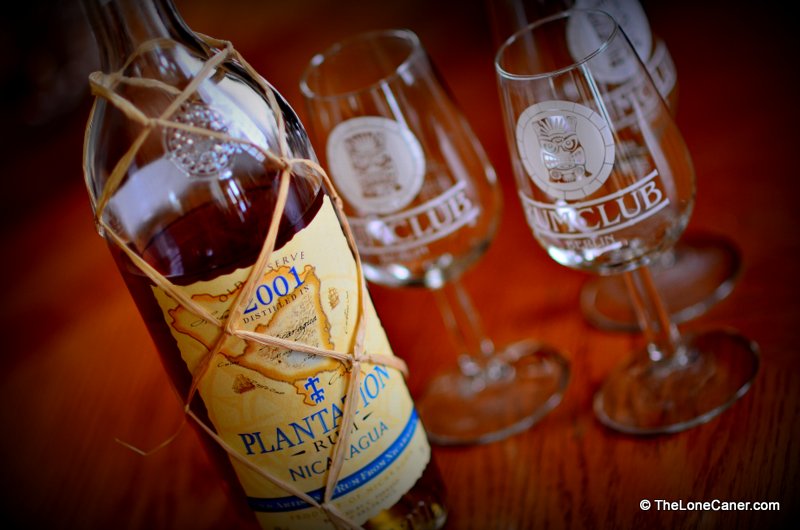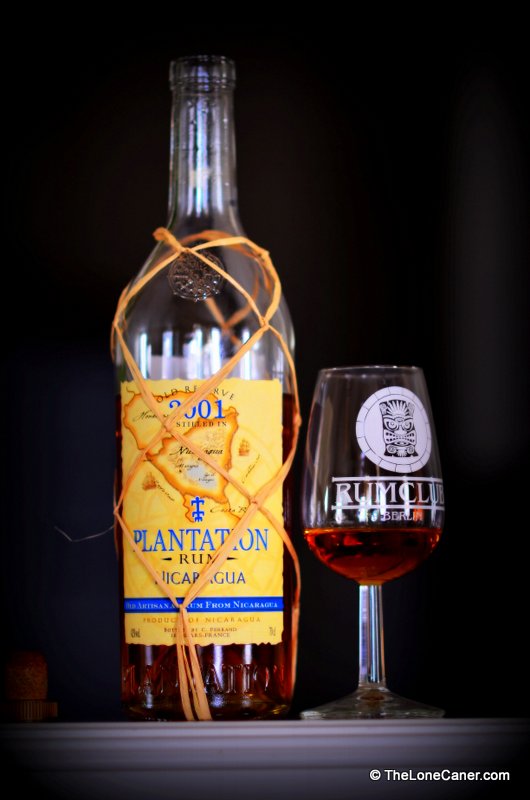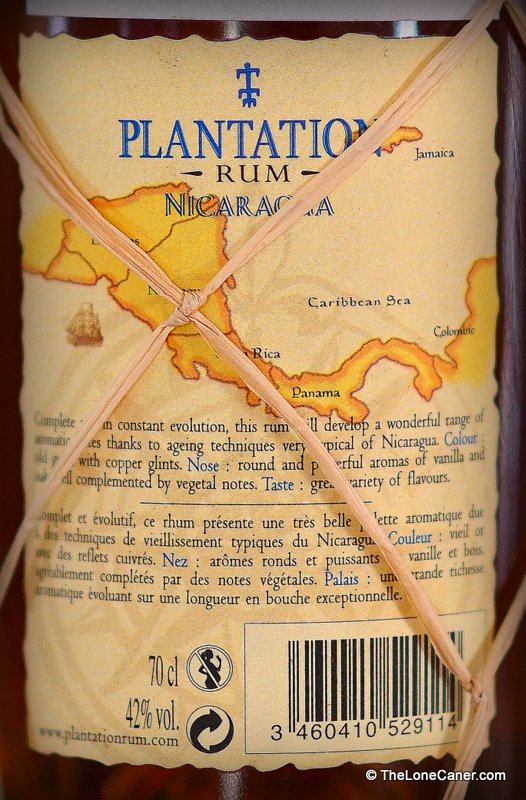
A very good double-aged Nicaraguan rum, from France. If this is what a random selection of Plantation rums is like, then I have high hopes for all the others.
Finally, I have managed to start acquiring some of the Plantation rums (long regarded by me as a major hole in the reviews of rum “series”), and if the Law of Mediocrity holds true, then this is a set of bottlings that would remedy all my bitching about the inconsistencies of the Renegade line. If it is true that the characteristic of the parts is a function of the whole, then we’ll be in for a treat as we work our way through them.
The Plantation line of rums is made by Cognac Ferrand of France, based on stocks bought from around the Caribbean and Central and South America, and some of their uniqueness rests in the fact that they are finished in cognac casks prior to final bottling (so they can be regarded as double aged). This gives the rums in the line a certain heft and complexity that many comment on quite favourably, to say nothing of the line stepping away from 40% as a matter of habit – this one from Nicaragua was bottled at a pleasant 42%. Note also that Plantation indulges the practice of dosing – the addition of small amounts of sugar or caramel to create the overall assembly.

The bottle itself conformed to the Plantation standard of presentational ethics: a straw-netting enclosed barroom bottle, with the label identifying the year the rum was laid down (2001 in this case), and a map of the source country. I guess they saved the really fancy presentation for stuff like the Barbados 20th Anniversary edition, which was nothing near to this kind of standard (it was better), yet I have no fault to find here, since aside from the lack of an age statement, it provided most of what I needed.
It’s been a while since I tasted the Flor de Cana series of rums (my stocks are long since drained and not renewed), but I remembered the solidity of those, the depth of flavour, whether simple or complex, and they remained among my favourites until supplanted by other Panamanian and Guyanese expressions. This rum brought back all my memories of why I liked Nicaraguan products so much
The nose was deep and rich, redolent of vanilla, oak (not excessive, very well balanced), caramel, citrus (orange peel, even lime zest) and peaches (minus the cream). There were herbal notes flitting around the initial delectable aromas, and I reveled in the lemon grass scents which reminded me somewhat of crushed lime leaves in spicy Thai cuisine. There was no offensive astringency or bite here, just solid, complex notes I spent an inordinate amount of time admiring.
The palate was lovely. 42% ABV sent a pleasantly heated, medium bodied spirit to announce its prescence with a smoothly powerful fanfare. Honey and caramel flavours led the charge, with subtler tastes of pineapple, a ripe-but-firm mango and vanilla rounding things out. The Nicaragua 2001 was not overly sweet (so what dosing they did do was judiciously restrained, at least), slightly dry without being either cloyingly sugary, or acerbically briny. The rum was all well-balanced flavour and profile, speaking well for more expensive and older rums up the chain of the Plantation line. And I had little fault to find with the finish, which was longish, slightly dry and gave me some oak and vanilla that was not exceptional, just well put together

What’s not to admire about a rum like this? Much like the Dictador 20 written about some weeks back, it displayed a solid mastery of rum-making fundamentals. It’s probably the finishing in cognac casks that gave it that extra note of complexity and balance I so enjoyed here, with the body being somewhat enhanced by the sugar (estimated at 14 g/L). In part, I see the production of these limited edition bottlings by European makers as an act of homage for the traditions of the old rum makers and their lost arts. W.G. Sebald, whose works often concerned the loss of memory, once wrote about journeys made through the half-abandoned remainders of the past, through signs that men had once been here and are now forgotten. When you try the Nicaragua 2001, you see what rum can be, once was, and maybe what it will aspire to in years to come.
(#154. 85.5/100)
Other notes
- The Law of Mediocrity isn’t quite what it sounds like: it basically takes the position that if one takes a random sample from a set and that sample is good, then it suggests that others in the set will also be.
- There is no literature I can find that says precisely how old the rum is. Of course, since it was casked in 2001, it has to be less than fifteen years old. One German site stated it was six years old, and the Fat Rum Pirate (the only other review out there) says he guesses 8-10, so I dunno…..
- There is some confusion in the online literature as to whether this is pot still or column still distillate. However, the Cognac-Ferrand site notes it as coming from a columnar still.
- People have differeing opinions on the matter of additional sugar, an imbroglio which became a major issue in late 2014 onwards. Some like it, some don’t, some are indifferent. The 14g/L number is taken from The Fat Rum Pirate’s list.
Does this have a powerful, fresh, maybe grassy, sugar cane blast like a young Havana? But no high esters like nail polish, plastics, varnish, unripe banana skins, solvents like in Jamaican, Pusser blue, a St Lucia white had! Never had a Barbados or Trindad either! So many regions! So far its seems its south america I’m after. A fresh cane stalk cut aroma or think molasses be good.Not too thin, ethanol, mellow. I’m lost how rums cane have high esters as mentioned as a fresh cane don’t smell like that?
I’m not sure if you’re making a statement about your observations or asking a question about them.
Would Nicaragua plantation have high esters Ethyl acetates like Nail polish solventy? Volcanic island so not sure on cane taste? I’ve read your reviews and you seem to like a bit assertive cane and not too thin too. I’ll keep checking the reviews. Do you have favorite rums for cola?
1. The proportion of esters in the final product has a lot to do with fermentation technique, distillation technique and how the cuts are made, so Nicaragua has the potential. I never tasted a whole bunch myself, though.
2. Any rum that I mix — in a cola or any other cocktail — will be simple and low-end and cheap.